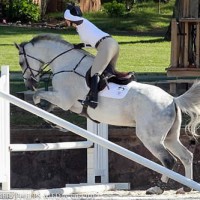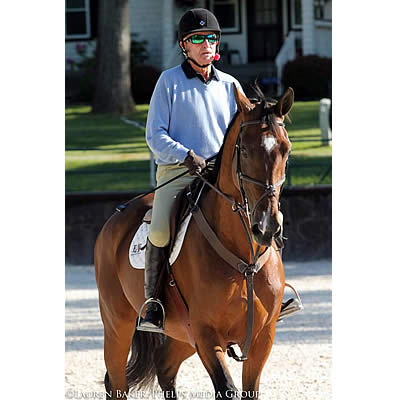George H. Morris rides MDC Athena.
Gladstone, NJ – May 22, 2015 – Four days into the United States Equestrian Team Foundation’s “Gladstone Program,” the sun finally peeked out over the historic Hamilton Farm, casting a soft glow on the property as the riders cleaned stalls, fed and groomed their horses.
When the clock struck 8 a.m., Lisa Goldman, Kilian McGrath and Katie Cox strode into the outdoor arena, with Sean Leckie surrendering MDC Athena to master horseman George H. Morris.
The ring setup was identical to that of day three, except for the addition of a five-stride line with a big crossrail leading to the water jump.
“Make friends with your horse,” Morris said. “This is more for the rider. It shows a good relationship with the horse…”
The audience scribbled notes, awaiting the master’s prophetic conclusion: “This is called petting.”
After a laugh, the lesson began at the walk, with riders “turning on their engines,” having forward impulsion to encourage the horses to be light and responsive. The riders focused on keeping the horses straight, using the inside leg to drive.
Morris instructed the riders to follow him at a trot, alternating between shoulder-in and haunches-in around the ring, giving and taking with the reins to encourage the horses to drop their heads and raise their backs.
The riders finished working laterally, returning to straight lines to lengthen and shorten the horses’ strides, incorporating the cavaletti as they changed direction and following Morris like baby ducks in a line.
When Morris transitioned to the counter canter, like three baby ducks the riders followed suit, using their inside legs to regulate the impulsion and half halts to encourage the horse to carry itself.
“We have to be listening to the horse, but it takes two to dance,” Morris said. “The horse has to want to do it for itself.”
After a few flying changes, the riders dropped back down to a trot, holding their reins on the buckle to allow the horses to really stretch in preparation for jumping.
Morris explained the upcoming activity for the bounce, which included changing the left hand’s position every time he shouted a number.

“One!” Left arm out to the side, parallel to the ground. “Two!” Hand to the chest. “Three!” Hand to the hip. “Four!” Hand on the head. “Five!” Arm behind the back.
The riders took turns through the bounce, snapping their hands to the proper positions as Morris shouted the numbers over the loudspeaker. A sharp “next!” from Morris kept the line moving steadily.
“This type of exercise is indispensable,” Morris said. “Indispensable for riding, indispensable for jumping.”
After a few comical repetitions, the riders moved on to the outside triple, working on adding four strides in a three, and pulling up and facing the rail whenever Morris dictated. The horses and riders were learning not to rush, and that speed is never the answer to a sticky situation.
Finally, riders navigated a course starting with the skinny, moving to a bending line from the liverpool to an oxer and ending with the crossrail and, five strides later, the infamous water jump. However, to everyone’s slight surprise, all the horse-and-rider combinations handled it without a single hiccup.
“Great horses, people. We have two excellent groups,” Morris commented, ending group one’s lesson for the day.
Shortly after, Taylor Harris, Kate Mulligan and Sohpie Verges arrived at the arena, while Morris got a leg up on to Haley Gassel’s 17.2 hand Quiet Dark 2.
The group warmed up at the walk, trot and canter, completing the same shoulder-in, shoulder-out exercises as the previous group, making transitions and circles, lengthening and shortening the stride and practicing staying straight during flying lead changes.
“This isn’t just dressage chit-chat,” Morris reminded everyone. “It’s for all disciplines. All horses are different, but after they’re ridden in classical style, they go the same. It’s so easy that you people don’t get it.”
After doing the same balance exercise through the bounce, riders moved on to practice pulling up in the triple combination.
“Point the horse at the barrier,” Morris instructed. “I promise that horse will stop. A tree, a group of people, a wall, a fence; I love to gallop at the Ferraris in Wellington. I’ll gallop to a Porsche. Horses can stop very quickly, people.”
The riders moved on to complete the same course from the morning, again without hesitation at the water jump, leaving Morris highly impressed with the horses and riders.
As the horses cooled down, Morris turned his golf cart to face the spectators and delivered more wise words about the importance of self-carriage in horses: “Riders today carry horses because they have to sell them. It breaks my heart to see the hunters go today. That self-proficient hunter system never gave bad results. In fact, we had our best results, and riders want to change it. Not when I teach you. No, no, no.”
The Gladstone Program will continue Saturday morning with over-fences sessions at 8 a.m. and 10 a.m. Riding sessions are open to the public for auditing.
The United States Equestrian Team Foundation (www.uset.org) is the non-profit organization that supports the competition, training, coaching, travel and educational needs of America’s elite and developing international, high-performance horses and athletes in partnership with the United States Equestrian Federation.
For more information on the USET Foundation, please call (908) 234-1251, or visit USET ONLINE at www.uset.org.
The USET Foundation has been awarded Charity Navigators’ highest honor, a Four Star rating for good governance, sound fiscal management and commitment to accountability and transparency.
Contact: Rebecca Walton
USET Foundation
phone 561.753.3389 fax 561.753.3386
rjw@phelpsmediagroup.com
PhelpsMediaGroup.com
